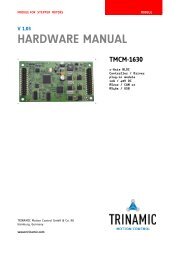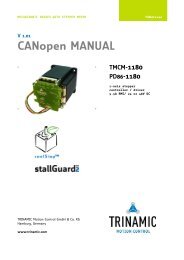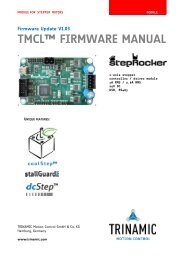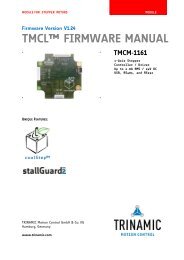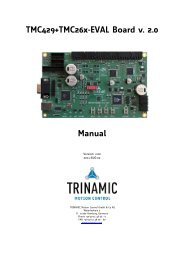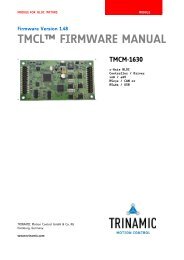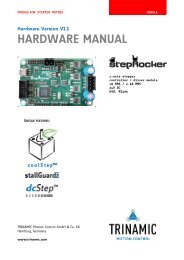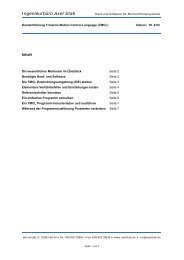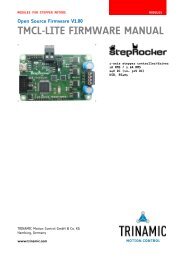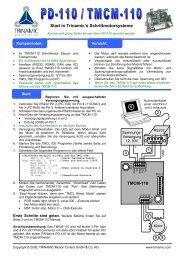TMC428 – Application Note - Trinamic
TMC428 – Application Note - Trinamic
TMC428 – Application Note - Trinamic
Create successful ePaper yourself
Turn your PDF publications into a flip-book with our unique Google optimized e-Paper software.
<strong>TMC428</strong> <strong>–</strong> <strong>Application</strong> <strong>Note</strong> <strong>–</strong> <strong>TMC428</strong> Getting Started <strong>–</strong> Including StallGuard TM 15<br />
(v. 2.00 / April 14, 2008)<br />
-LD<br />
range of<br />
low BEMF<br />
4.5 StallGuard <strong>–</strong> General Constrains<br />
Copyright © 2005-2008 TRINAMIC Motion Control GmbH & Co. KG<br />
resonance<br />
best velocity ranges for<br />
proper operation<br />
range of<br />
torque<br />
decrease<br />
Figure 8 : Outline of a typical StallGuard Profile<br />
Velocity Ranges for Proper Operation of StallGuard<br />
For StallGuard, on should run the stepper motor within the velocity ranges that are best for proper<br />
operation of StallGuard. For a given stepper motor, these ranges can be determined using the<br />
StallGuard Profiler. Although it is not the goal of the StallGuard profiler, it can be used to determine the<br />
resonance frequency of a stepper motor.<br />
Proper velocities of operation for StallGuard are those with low LD bit vector value and low standard<br />
deviation. Without load, one gets load indicator bit vector LD. Under mechanical load at the axis of the<br />
stepper motor, one gets a lower value of the load indicator bit vector LD.<br />
So, velocities with high load indicator values are good for StallGuard. Low standard deviation means,<br />
that one gets stable load indicator bits. The load indicator values might vary by one if they are close to<br />
one of the internal thresholds of the TMC246 / TMC249 stepper motor drivers at a given velocity.<br />
Mixed-Decay to be set OFF for StallGuard<br />
The mixed-decay (MD) feature of the TMC246 and TMC249 has to be set off (MDA='0', MDB='0')<br />
when using StallGuard. This is because the mixed-decay forces a better current regulation but it<br />
regulation disadvantageously interferes the measurements of StallGuard. Under special conditions,<br />
StallGuard might work together with mixed-decay, but with restrictions.<br />
Full Step vs. Half Step vs. Micro Step<br />
StallGuard is compatible with full stepping, but it gives the best performance with micro stepping due to<br />
lower mechanical resonances of the stepper motor when driven by micro stepping [Larsson2003].<br />
Resistances<br />
The coil resistance of a stepper motor and the resistance of the sense resistors should be of the same<br />
order of magnitude <strong>–</strong> not of same value. Stepper motors of low coil resistance are advantageous in<br />
most cases, because those kinds of stepper motors mostly have a higher efficiency. On the other<br />
hand, a higher resistance of the sense resistors improves the StallGuard by higher signal amplitude of<br />
the sense signal and by lower signal noise ratio. For higher resistance sense resistors one can use a<br />
higher external reference voltage of up to 3V ((please refer TMC246 / TMC249 datasheets for details).<br />
v



